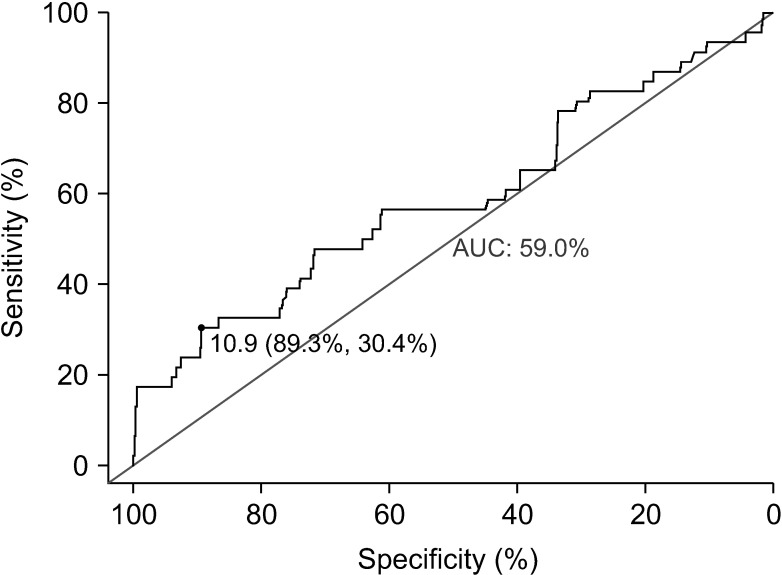1. Hall J, Hammerich K, Roberts P. New paradigms in the management of diverticular disease. Curr Probl Surg. 2010; 47:680–735. PMID:
20684920.

2. Paik PS, Yun JA. Clinical features and factors associated with surgical treatment in patients with complicated colonic diverticulitis. Ann Coloproctol. 2017; 33:178–183. PMID:
29159165.

3. Shin S, Kim D, Kang UR, Yang CS. Impact of CT imaging on predicting the surgical management of acute diverticulitis. Ann Surg Treat Res. 2018; 94:322–329. PMID:
29854710.

4. Bates DD, Fernandez MB, Ponchiardi C, von Plato M, Teich JP, Narsule C, et al. Surgical management in acute diverticulitis and its association with multi-detector CT, modified Hinchey classification, and clinical parameters. Abdom Radiol (NY). 2018; 43:2060–2065. PMID:
29204676.

5. Matsushima K. Management of right-sided diverticulitis: a retrospective review from a hospital in Japan. Surg Today. 2010; 40:321–325. PMID:
20339986.

6. van Dijk ST, Daniels L, de Korte N, Stockmann HB, Vrouenraets BC, J Consten EC, et al. Quality of life and persistent symptoms after uncomplicated acute diverticulitis. Dis Colon Rectum. 2019; 62:608–614. PMID:
30807455.

7. Bolkenstein HE, Consten ECJ, van der Palen J, van de Wall BJ, Broeders IA, Bemelman WA, et al. Long-term outcome of surgery versus conservative management for recurrent and ongoing complaints after an episode of diverticulitis: 5-year follow-up results of a multicenter randomized controlled trial (DIRECT-Trial). Ann Surg. 2019; 269:612–620. PMID:
30247329.
8. Jaffer U, Moin T. Perforated sigmoid diverticular disease: a management protocol. JSLS. 2008; 12:188–193. PMID:
18435896.
9. Coebergh JW, Janssen-Heijnen ML, Post PN, Razenberg PP. Serious co-morbidity among unselected cancer patients newly diagnosed in the southeastern part of The Netherlands in 1993–1996. J Clin Epidemiol. 1999; 52:1131–1136. PMID:
10580775.

10. Kaiser AM, Jiang JK, Lake JP, Ault G, Artinyan A, Gonzalez-Ruiz C, et al. The management of complicated diverticulitis and the role of computed tomography. Am J Gastroenterol. 2005; 100:910–917. PMID:
15784040.

11. Huang YQ, Gou R, Diao YS, Yin QH, Fan WX, Liang YP, et al. Charlson comorbidity index helps predict the risk of mortality for patients with type 2 diabetic nephropathy. J Zhejiang Univ Sci B. 2014; 15:58–66. PMID:
24390745.

12. Chen JH, Zhai ET, Yuan YJ, Wu KM, Xu JB, Peng JJ, et al. Systemic immune-inflammation index for predicting prognosis of colorectal cancer. World J Gastroenterol. 2017; 23:6261–6272. PMID:
28974892.

13. Kishiki T, Masaki T, Matsuoka H, Kobayashi T, Suzuki Y, Abe N, et al. Modified Glasgow prognostic score in patients with incurable stage IV colorectal cancer. Am J Surg. 2013; 206:234–240. PMID:
23827511.

14. Hu P, Shen H, Wang G, Zhang P, Liu Q, Du J. Prognostic significance of systemic inf lammation-based lymphocyte- monocyte ratio in patients with lung cancer: based on a large cohort study. PLoS One. 2014; 9:e108062. PMID:
25275631.
15. Ranzani OT, Zampieri FG, Forte DN, Azevedo LC, Park M. C-reactive protein/albumin ratio predicts 90-day mortality of septic patients. PLoS One. 2013; 8:e59321. PMID:
23555017.

16. Hall JF, Roberts PL, Ricciardi R, Read T, Scheirey C, Wald C, et al. Long-term followup after an initial episode of diverticulitis: what are the predictors of recurrence? Dis Colon Rectum. 2011; 54:283–288. PMID:
21304297.

17. Strassle PD, Kinlaw AC, Chaumont N, Angle HL, Lumpkin ST, Koruda MJ, et al. Rates of elective colectomy for diverticulitis continued to increase after 2006 guideline change. Gastroenterology. 2019; 157:1679–1681. PMID:
31499038.

18. El-Sayed C, Radley S, Mytton J, Evison F, Ward ST. Risk of recurrent disease and surgery following an admission for acute diverticulitis. Dis Colon Rectum. 2018; 61:382–389. PMID:
29420430.

19. Feingold D, Steele SR, Lee S, Kaiser A, Boushey R, Buie WD, et al. Practice parameters for the treatment of sigmoid diverticulitis. Dis Colon Rectum. 2014; 57:284–294. PMID:
24509449.

20. Hupfeld L, Burcharth J, Pommergaard HC, Rosenberg J. Risk factors for recurrence after acute colonic diverticulitis: a systematic review. Int J Colorectal Dis. 2017; 32:611–622. PMID:
28110383.

21. Chapman JR, Dozois EJ, Wolff BG, Gullerud RE, Larson DR. Diverticulitis: a progressive disease? Do multiple recurrences predict less favorable outcomes? Ann Surg. 2006; 243:876–830. PMID:
16772791.
22. Ho VP, Nash GM, Milsom JW, Lee SW. Identification of diverticulitis patients at high risk for recurrence and poor outcomes. J Trauma Acute Care Surg. 2015; 78:112–119. PMID:
25539211.

23. Salem L, Anaya DA, Flum DR. Temporal changes in the management of diverticulitis. J Surg Res. 2005; 124:318–323. PMID:
15820264.

24. Richards RJ, Hammitt JK. Timing of prophylactic surgery in prevention of diverticulitis recurrence: a cost-effectiveness analysis. Dig Dis Sci. 2002; 47:1903–1908. PMID:
12353827.
25. Mari A, Khoury T, Lubany A, Safadi M, Farraj M, Farah A, et al. Neutrophil-to-lymphocyte and platelet-to-lymphocyte ratios are correlated with complicated diverticulitis and hinchey classification: a simple tool to assess disease severity in the emergency department. Emerg Med Int. 2019; 2019:6321060. PMID:
31485352.

26. Reynolds IS, Heaney RM, Khan W, Khan IZ, Waldron R, Barry K. The utility of neutrophil to lymphocyte ratio as a predictor of intervention in acute diverticulitis. Dig Surg. 2017; 34:227–232. PMID:
27941316.

27. Kang HS, Cha YS, Park KH, Hwang SO. Delta neutrophil index as a promising prognostic marker of emergent surgical intervention for acute diverticulitis in the emergency department. PLoS One. 2017; 12:e0187629. PMID:
29091955.

28. Mäkelä JT, Klintrup K, Rautio T. The role of low CRP values in the prediction of the development of acute diverticulitis. Int J Colorectal Dis. 2016; 31:23–27. PMID:
26519151.

29. van de Wall BJ, Draaisma WA, van der Kaaij RT, Consten EC, Wiezer MJ, Broeders IA. The value of inflammation markers and body temperature in acute diverticulitis. Colorectal Dis. 2013; 15:621–626. PMID:
23088216.






 PDF
PDF Citation
Citation Print
Print








 XML Download
XML Download